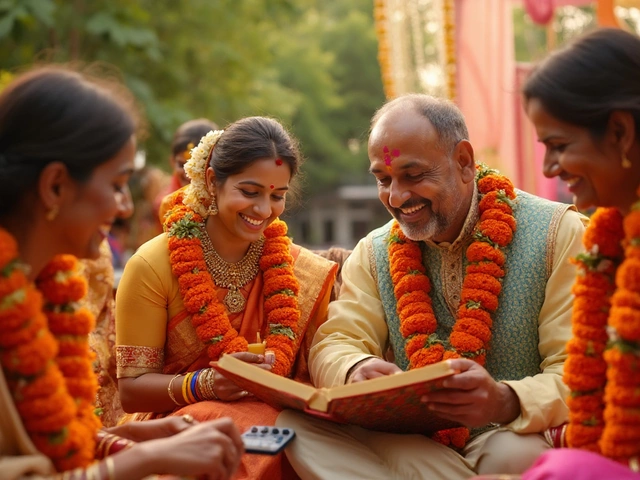
People always have an opinion on who should pay for a wedding, and the conversation gets awkward fast. One glance at social media or a wedding planning group, and you’ll find fired-up debates: Should the bride’s family still foot the bill, like old-school tradition says? Or should couples split it, handle it themselves, or go Dutch with both families? Here's what’s wild: the average American wedding cost in 2024 was just under $34,000, according to The Knot—the highest it’s been in nearly a decade. That’s not a bill you just slip into a purse. And no wonder nearly half of engaged couples in the U.S. said wedding costs gave them "persistent financial stress." So, who actually pays, and how do you talk about it without wrecking the vibe before you even cut the cake?
The Origins and Evolution of Wedding Payment Traditions
This whole idea that the bride’s family should cover wedding expenses actually dates back hundreds of years. Think European traditions, dowries, and situations where a daughter was considered a "financial burden" until marriage. Fast forward to the 20th century, and that expectation got cemented in American pop culture—think movies, TV, and dusty etiquette books. The groom’s family, meanwhile, was typically responsible for the rehearsal dinner, the groom’s outfit, and sometimes booze at the reception.
But times change fast. Research from Zola and WeddingWire in the last two years shows that only about 24% of American weddings are now fully paid for by one side of the family. Same-sex couples, blended families, and people marrying later change the landscape even more. Couples in their late 20s and early 30s—who make up most of today’s brides and grooms—often want total control over the guest list, menu, and music. If your folks are footing the bill, suddenly you’re navigating their opinions on everything from venue to veil. Couples today are also less likely to accept the "who pays decides the rules" philosophy.
Interesting fact: In 2022, a WeddingWire poll found that 48% of couples paid for most of their own wedding, with around a third accepting contributions from both sets of parents. Less than a quarter went the "traditional" bride’s family route. What does this tell you? Tradition is being replaced by conversations, compromises, and a new spirit of teamwork.
Average Wedding Costs and Who Pays What
If you’re wondering where that $34,000 price tag comes from, you’re not alone. Let’s break it down with actual 2024 figures. Who should pay for a wedding isn’t just an etiquette question—it’s usually about splitting some serious costs. Here’s a basic breakdown, pulled from data published by The Knot and Brides.com in mid-2024:
| Expense | Average Cost (USD) | Traditionally Paid By |
|---|---|---|
| Venue (Rental + Food & Drink) | $12,500 | Bride’s Family |
| Photography & Videography | $4,000 | Bride’s Family |
| Attire/Beauty | $2,800 | Bride’s Family |
| Flowers & Decor | $2,600 | Bride’s Family |
| Entertainment/Music | $2,400 | Bride’s Family |
| Groom’s Attire | $350 | Groom’s Family |
| Rehearsal Dinner | $2,500 | Groom’s Family |
| Wedding Rings | $1,900 | Groom (or both) |
| Stationery (Invites, Thank Yous) | $600 | Bride’s Family |
The table tells a clear story: old-school customs expect the bride’s family to cover the lion’s share. But these numbers are a lot more complicated when you start factoring in real budgets, priorities (think: maybe you skip flowers and splurge on music?), or two families with wildly different financial situations. It gets even trickier with guests pitching in, modern registry options like Honeyfund for "honeymoon donations," or couples who just elope to save bank.

Common Ways Couples and Families Split Costs Today
So if most people aren’t following the “bride’s family pays for everything” rule, how are folks doing it? Here are popular options couples and families are using right now:
- Each pays their own way: The couple covers everything with their own savings or a tiny loan. This gives autonomy, but it’s also the most expensive personally (especially in higher-cost cities like New York or San Francisco).
- Split down the middle: Both families contribute equally, or as close as possible. This is common for couples whose parents are both willing and able to help, but nobody wants to outshine the other.
- Selective sponsorships: Maybe one family pays for the rehearsal dinner or the DJ, the other handles food and drinks, friends chip in for a photo booth or dessert table. This mix-and-match method is super normal among blended families or second marriages.
- Proportional based on ability: The couple talks honestly with each side about how much they can realistically pitch in. If you’re both self-reliant but your one set of parents can comfortably afford a venue, maybe they pay for that piece and you handle the rest.
- Elopement or micro-wedding: Some couples use the family money as a "honeymoon fund" or down payment on a house instead, then keep the ceremony tiny and inexpensive.
Stats from a 2024 Zola survey show nearly 80% of couples said they discussed who would pay for what before signing any major contracts. The couples who didn’t talk about it up front? 65% of them reported regretting it, and arguments about finances were the top reason. Ouch.
One tip that really helps: use a tracked spreadsheet or a budgeting app. There are wedding-specific tools like WeddingWire’s Budget Planner, which lets you link contributions and payments directly, so everyone knows what’s covered and when.
How to Have the Money Talk—Without the Drama
This is the part nobody wants to do, but skipping it leads to the messiest fights. Start early, way before you book a venue or put down any deposits. Here’s how real couples have made it work—and what actual wedding planners recommend:
- Start with your vision. What do you both truly want? An intimate backyard gathering? A destination party? A super-traditional black-tie bash?
- Set your non-negotiables—what would ruin the day if you had to cut it?
- Get a ballpark budget for what those things cost in 2025. Many venues now list package prices online. Ask recently married friends for their honest spreadsheets. Don’t forget sneaky extra fees.
- Once you know what you’re dealing with, sit down with each set of parents, separately or together, and talk through your numbers. Be honest about expectations but also flexible.
- Write down who is paying for what—or what amount each person is giving. It can be awkward, but written agreements erase confusion weeks later.
- If any party can’t contribute or prefers to put money toward something else (the honeymoon, a house, future grandkids' savings), don’t force the issue. There are lots of ways to show support.
- Remember, this is a conversation, not a negotiation. Thank each person, and avoid putting anyone on the spot or pitting families against each other.
Something almost nobody talks about: Some families feel pride in hosting and would be hurt if left out, while others would rather the couple take charge. Understanding family culture and personal feelings matters just as much as money. Pro tip from a wedding planner in Chicago: Always ask about "hidden contributors." Sometimes a grandparent or aunt wants to gift the dress, cover the cake, or sponsor an open bar as a surprise.

Modern Tips to Fund Your Wedding Without Losing Your Mind (Or Friends)
If the math seems overwhelming, you’re not alone. Here are some new-school strategies and clever tips people are actually using:
- Set a micro-budget and stick to it: Decide what you can truly afford without debt. 2024 saw a 20% increase in backyard weddings with guest lists under 40—a trend driven by inflation and people wanting to keep it personal and calm.
- Get creative with tech: Fund registries like Zola and Honeyfund let guests pitch in for experiences not just blenders and tableware. You can crowd-source some costs without making it feel like a GoFundMe free-for-all.
- Time-shift expenses: Instead of pre-wedding showers, some couples host low-key "after-parties" (second receptions) for out-of-town family a month or two later—much more budget-friendly.
- Book off-season or alternative venues: Winter weddings are now up 18% since 2022, partly because they’re generally 30% cheaper for venues, floral, and music. Art galleries, breweries, and funky Airbnb rentals are getting popular as unique venues that charge less and need less decor.
- Negotiate everything: Price isn’t always fixed for food, photos, or cake. Many vendors offer discounts for payment up front, weekday bookings, or bundled services. Real talk: Just ask, and you might knock off hundreds (sometimes thousands!).
- Focus on experience over things: The happiest couples in a recent NYT Modern Love report said spending on food, music, and the photographer mattered most, while skimping on the dress, paper invites, and party favors made zero impact on joy.
- Communicate early and often: Keeping everyone in the loop squashes resentment and ensures surprises are the fun kind—not the credit card bill kind.
One gentle reminder from almost every financial expert: Whatever method you pick, don’t start your marriage deep in new debt. Being honest about what’s possible now usually beats wishing you could rewind a year from now when the payments are due.
So, there’s no single answer to "who should pay for a wedding." Family culture, budgets, and values are all part of the mix. But one thing is universal: talking through it early, keeping expectations real, and focusing on what matters (hint: the people, not just the Pinterest board) results in a wedding—and a marriage—that starts with teamwork, not tension.



Comments
Post Comment